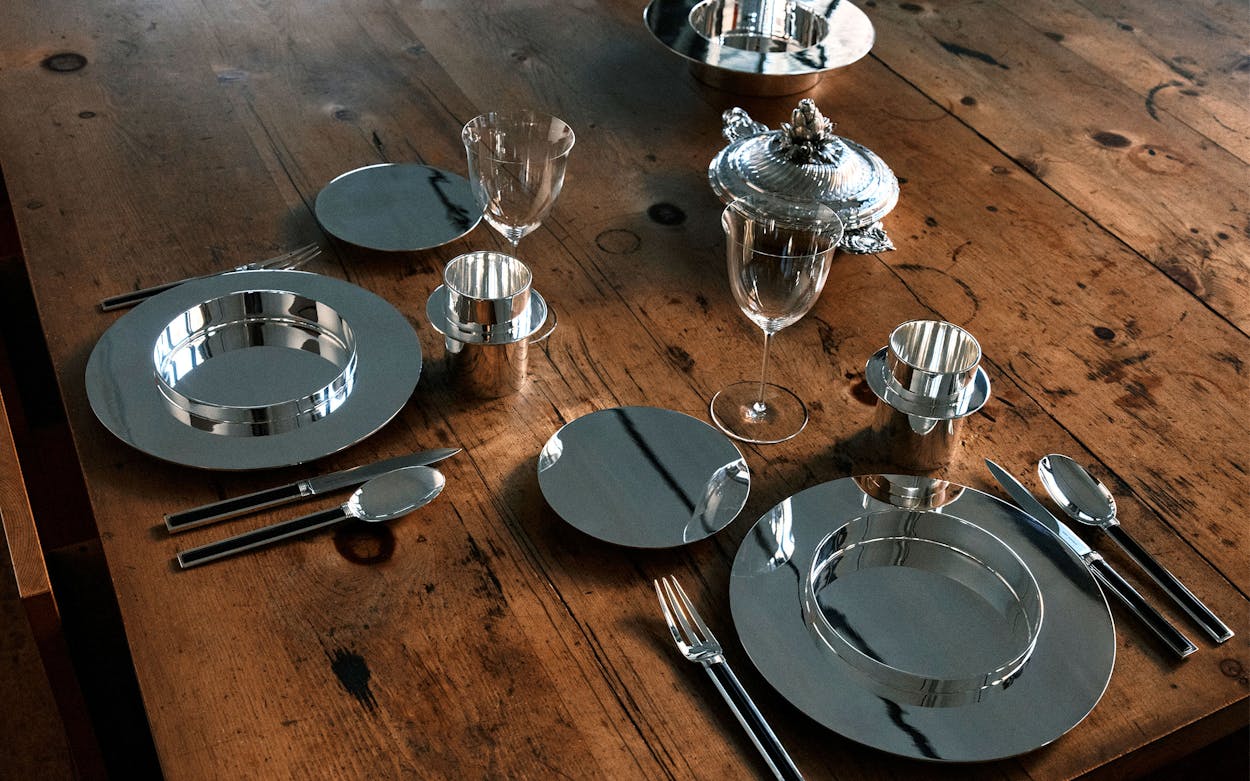In 1989, only five years before his sudden death, renowned artist Donald Judd sketched designs for a series of tableware items at his studio in Marfa. The various dining vessels—consisting of cups, plates, and bowls—were made up of cylindrical forms intersected by sharp, ninety-degree angles. The pared-down shapes, reminiscent of his sculptures and furniture, were simple and elegant on paper, yet complicated to fabricate.
He had prototypes made in both ceramic and stainless steel, but they lacked the exacting edges he envisioned in his drawings. So he tucked them away, never to be reattempted in another material. Now, almost three decades after his death, thanks to a partnership between luxury silver studio Puiforcat and the Judd Foundation, the vessels have been realized—this time in solid sterling silver.
“This collaboration happened by chance, thanks to a visit of the Judd Foundation with Flavin, the artist’s son,” said Charlotte Macaux Perelman and Alexis Fabry, the artistic directors of Puiforcat, over email. “During the discussion, he mentioned this collection imagined by his father.” Flavin Judd oversaw the collaboration as part of his duties as artistic director of the foundation, which maintains and preserves the artist’s permanently installed living and working spaces in Marfa and New York.
Pages of the artist’s sketches and technical drawings, housed in the Marfa archive, were scanned and sent off to Puiforcat’s headquarters, in Paris. The eight-piece service of dinner, bread, soup, salad, and dessert plates, bowls, and cups is now available for purchase, with prices ranging from $6,000 for a small plate to $22,000 for a serving platter.
“There were a set of engineered drawings for this set, so it was very clear what they were supposed to look like. The process and working with the craftspeople at Puiforcat was great,” said Flavin in an email. “Silver is a very specific material and like all materials it has limits. [Those] limits tell you what to do.” Puiforcat’s silversmiths keep the craft metal at the same temperature to maintain malleability and use a molten-filler technique so that no welding points are visible along the perpendicular edges. Keeping the surface free of any imperfections is extremely difficult to do. Though most of Judd’s work makes use of more utilitarian materials, Flavin says that his father did consider silver as a potential material for his tableware.
Throughout his decades-long career, which spanned the fields of art, architecture, and industrial design, Judd used primarily industrial materials, such as aluminum, galvanized iron, and stainless steel, to build his geometric, three-dimensional art objects. His works—such as his well-known “stacks” of evenly spaced boxes, vertically mounted on walls—challenged traditional ideas about fine art and sculpture. His foray into furniture design began out of the need to fill his space in New York; he later outlined simple wooden bed frames, chairs, and tables for his Marfa space that were then fabricated by local carpenters. He went on to sell the successful designs, which are still available through the Judd Foundation.
Though Judd’s furniture and artworks shared some visual resemblances as paired-down, schematic shapes, he was careful to clarify the design process of a practical object versus that of a work of art. In his 1993 essay “It’s Hard to Find a Good Lamp,” one of his many art writings, Judd wrote that “the configuration and the scale of art cannot be transposed into furniture and architecture. The intent of art is different from that of the latter, which must be functional.” One has to wonder if Judd, writing this four years after the designs of his tableware items, was haunted by the unrealized vessels. They aren’t mentioned in the piece.
At Judd’s preserved two-story residence on “the Block” in downtown Marfa, many kitchen objects collected throughout the artist’s life are on display. His possessions were varied: stoneware jars, aluminum teapots, clay plates. One can imagine the almost otherworldly luxury silver dinnerware sitting near a humble terra-cotta bowl.
Given Judd’s resolve to remember an object’s function, these designer bowls would have been used—just as his collection of museum-worthy art hung from his walls for everyday appreciation. And what might he have served in this artisan-crafted silver? “Don could make steak and roast a chicken but nothing fancy,” said Flavin. “He made us lunch every day during lunch break from school, even if that was reheated beans and tortillas, which we ate a lot.”
- More About:
- Style & Design
- Donald Judd
- Marfa






